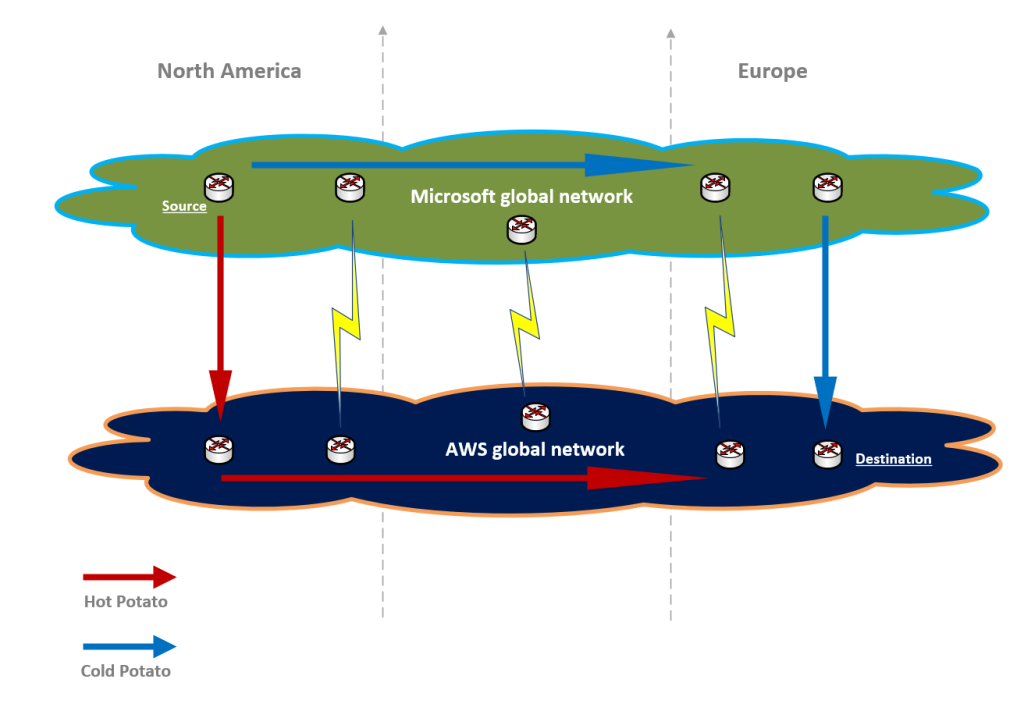Hot Potato vs Cold Potato Routing
Hot Potato and Cold Potato are two terms which describes how internet traffic is routed between different autonomous system (AS).
An autonomous system (AS) is a collection of connected Internet Protocol (IP) routing prefixes under the control of one or more network operators on behalf of a single administrative entity or domain, that presents a common and clearly defined routing policy to the Internet. Each AS is assigned an autonomous system number (ASN), for use in Border Gateway Protocol (BGP) routing.
Originally, the definition required control by a single entity, typically an Internet service provider (ISP) or a very large organization with independent connections to multiple networks, that adhered to a single and clearly defined routing policy.
Source: https://en.wikipedia.org/wiki/Autonomous_system_(Internet)
An Autonomous System (AS) is a group of IP networks run by one or more network operators with a single clearly defined routing policy. When exchanging exterior routing information, each AS is identified by a unique number. Exterior routing protocols such as BGP, described in RFC1771, “A Border Gateway Protocol 4 (BGP-4)”, are used to exchange routing information between Autonomous Systems. An AS will normally use some interior gateway protocol to exchange routing information on its internal networks.
Source: https://www.ripe.net/publications/docs/ripe-679
What is an AS Number?
An Autonomous System (AS) is a group of IP networks run by one or more network operators with a single, clearly defined routing policy.
When exchanging exterior routing information, each AS is identified by a unique number: the Autonomous System Number (ASN). An AS is also sometimes referred to as a routing domain.
Current RIPE Policy requires a network to be multi-homed, and have a unique routing policy for an ASN to be assigned. Requests must show the routing policy of the AS.
Any organisation can acquire an ASN. This requires a contractual agreement with a sponsoring LIR or with the RIPE NCC.
RIPE Database
Under the following link you can also search for specific ASN numbers by using a fulltext search for ASN number, network range or company name. (Link Simple and advanced search)
As mentioned, the terms are used if traffic needs to be routed between two autonomous system (AS) and if they will be interconnected in multiple locations (areas).
Hot Potato routing is the practice of passing traffic off to another autonomous system as quickly as possible whereas Cold Potato routing will route the traffic as long as possible within its own network near to the destination before passing it off to another autonomous system (network).
Imagine the following scenario below, a network packet needs to be send from a computer (source) which is connected to the Microsoft global network in North America to a computer (destination) which is connected to the AWS global network in Europe.
Because both networks (autonomous system) are interconnected in multiple locations between North America and Europe, the network packet can be passed from the Microsoft global network to the AWS global network at several locations on its way to the destination in Europe. Locations (BGP router) which are more near to source where the network packet was send or locations (BGP router) where more near to the destination.
Below in the figure you can see both practices.
Hot Potato the red arrow traffic flow where the network packet is passed over from the Microsoft global network to the AWS global network at the first possible location and BGP router which connects both networks.
Cold Potato the blue arrow traffic flow where the network packet is first routed as long as possible within the Microsoft global network and finally is passed over to the AWS global network just at the location and BGP router which is nearest to the destination location and BGP router.

Hot Potato routing is the normal behaviour of most networks and has the effect that the network receiving the data (aka downstream ISP) bears the cost of carrying it between locations.
Cold Potato routing in contrast is more expensive but keeps the traffic under the network administrator’s control for longer.
Microsoft Azure – What is routing preference?
Azure routing preference enables you to choose how your traffic routes between Azure and the Internet. You can choose to route traffic either via the Microsoft network, or, via the ISP network (public internet). These options are also referred to as cold potato routing and hot potato routing respectively. Egress data transfer price varies based on the routing selection. You can choose the routing option while creating a public IP address. The public IP address can be associated with resources such as virtual machine, virtual machine scale sets, internet-facing load balancer, etc. You can also set the routing preference for Azure storage resources such as blobs, files, web, and Azure DataLake. By default, traffic is routed via the Microsoft global network for all Azure services.
Source: https://learn.microsoft.com/en-us/azure/virtual-network/ip-services/routing-preference-overview
Links
Hot-potato and cold-potato routing
https://en.wikipedia.org/wiki/Hot-potato_and_cold-potato_routingWhat is routing preference?
https://learn.microsoft.com/en-us/azure/virtual-network/ip-services/routing-preference-overviewautonomous system (AS)
https://en.wikipedia.org/wiki/Autonomous_system_(Internet)Microsoft global network
https://learn.microsoft.com/en-us/azure/networking/microsoft-global-networkAWS global network
https://aws.amazon.com/about-aws/global-infrastructure/global_network/Azure Routing Preference (aka hot and cold potato routing)
https://www.youtube.com/watch?v=T9DdmbwPKbk


